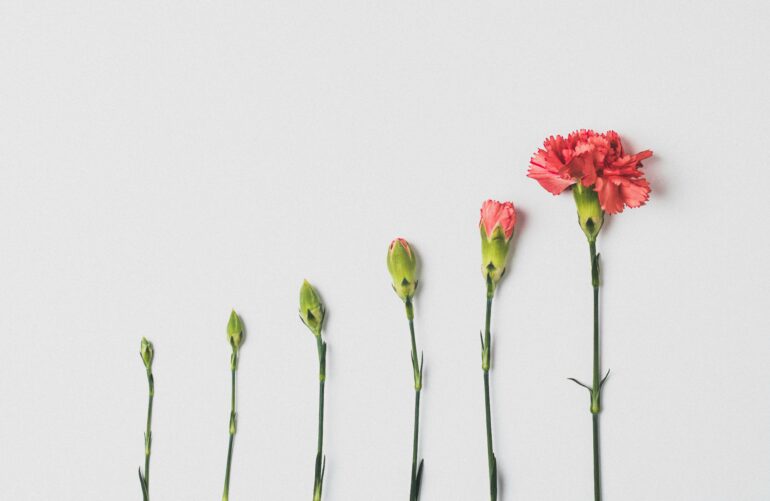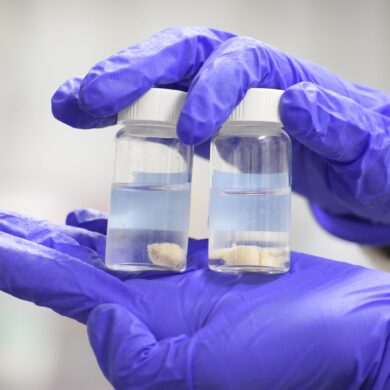On October 9th 2023, history was made as horticulturist, or plant cultivator, Travis Gienger successfully grew the largest pumpkin in the world. At a whopping 2,749 pounds, it’s hard to believe this gargantuan gourd came from a seed no bigger than a human thumbnail. How in the world does a plant pull off this type of growth?
Seed Germination
It all starts with embryogenesis, a developmental process in which the plant maps out its “body plan” through cell differentiation, or the process of creating new cells and various hormonal signals. By this time, the plant has turned from a single cell into a multicellular organism with built-in food reserves and a protective layer. This is also known as the seed. But the plant’s stuck in its own shell. How does it come out?
The plant breaks free from its cage through a process called germination. Like all good things, it only occurs when conditions are right: there has to be water uptake by the seed and the right ratio of ABA to GA hormones. ABA (Abscisic acid) and GA (Gibberellins) are both phytohormones, or plant hormones. ABA inhibits seed germination, and in general if a plant is producing more ABA, that means the plant is undergoing some type of stress due to environmental conditions. The most common is water stress (ie. drought conditions), in which a plant produces more ABA, telling its parts to slow down growth to conserve water and other nutrients. On the other hand, GA is a family of molecules that promote seed germination and stem growth in a plant. A low ratio is needed for the germination of a seed. There’s not a set value to reach as it changes for each plant species – in general the lower the ratio, the better the chance it has at germinating. That’s why it’s not uncommon to see plants that develop fruit only after a cold winter, such as the carrots you might see growing in UC San Diego campus’ community gardens. On the other hand, there are plants with seeds that only germinate after a fire, such as the Eucalyptus trees seen around UC San Diego.
The emergence of the radicle, or embryonic root, is one of the first visible successes of a growing plant. Closely following comes the stem and then the cotyledons, which are the first leaves of the plant. During this time the embryo undergoes polarized growth, which is another way to say the embryo establishes a sense of directionality and starts dividing its cells based on that directionality. The plant establishes two axes: the apical-basal axis( up-and-down), and the radial axis( in-and-out). Another family of phytohormones called auxins play a key role in developing this directionality. Auxins are tiny but mighty; they’re smaller than most other phytohormones, but are present in almost every stage of a plant’s life. They’re responsible for cell growth, and do this through sensing the plant’s environmental conditions. For example, light and gravity are important factors auxins react to in order for the plant to grow. That’s why you see plants, for example the pumpkin, will grow ‘towards’ the sun. This is from auxins in the plant concentrating towards the side where there is no sun, forcing cells on the other side to elongate towards the sun!
Cell Formation
So far, the plant has gotten a better sense of its bearings, but how does it actually create its leaves, flowers, spines, branches, and fruit? It differs between different types of plants, so let’s focus on the phylum ‘Angiosperm’, which includes the most recently evolved plants in the plant kingdom. Angiosperms encompass all plants that flower and bear fruit such as the pumpkin plant cared for by Mr. Geinger.
These plants organize themselves into their respective shoot and root systems. Each system is composed of different organs made of different tissues, similar to a human body’s organization. One kind of tissue, called meristematic tissue, is the source of all cell formation and growth in the plant. Think of it as a fountain of youth for the plant. There’s the SAM (shoot apical meristem) that form parts of the plant like leaves, stems, and flowers. Areas in which higher levels of SAM meristem cells are found are ‘peripheral zones’. This is where the leaves and flowers (which are bunches of highly modified leaves) are created. You can think of it as the plant’s ‘torso’. It has ‘arms’ that help it absorb sunlight and grow taller as it receives more nutrients. But these meristem cells aren’t the only players in this reaction. For instance, in flower formation, environmental conditions and a whole range of proteins called ‘transcription factors’ that help copy DNA, play big roles in whether or not a plant is able to flower at all.
Then there’s the RAM (root apical meristem) that facilitates root growth. From the radicle, the root grows downward with the help of gravity to form new cells coming from the RAM. Think of these as the plant’s ‘legs’. Although it can’t physically move, the roots aid the plant in finding nutrients, like how those late night food runs always hit the spot. There’s even a root cap covering the tip of the root to protect its RAM while traversing the underground terrain, similar to how a shoe is used to protect your feet.
Knowing all of this now, it’s clear to see there’s so much more going on in Travis Geinger’s pumpkin than just a pollinated flower turning into a fruit. The whole plant fights everyday to stay alive with help from its molecular mechanisms and systems, along with some luck from genetics. The growth of a pumpkin wasn’t just pure luck though; environmental conditions had to be favorable, the plant needed all its nutrients, and lots of tender loving care!
Links Used:
Squash goals: Minnesota man’s 2,749lb pumpkin sets world record | California | The Guardian
https://open.lib.umn.edu/horticulture/chapter/4-2-plant-hormones/
2.2: Introduction to Seed Germination – Biology LibreTexts
30.11: Plant Development – Meristems – Biology LibreTexts
Molecular mechanisms of flower development: an armchair guide | Nature Reviews Genetics

